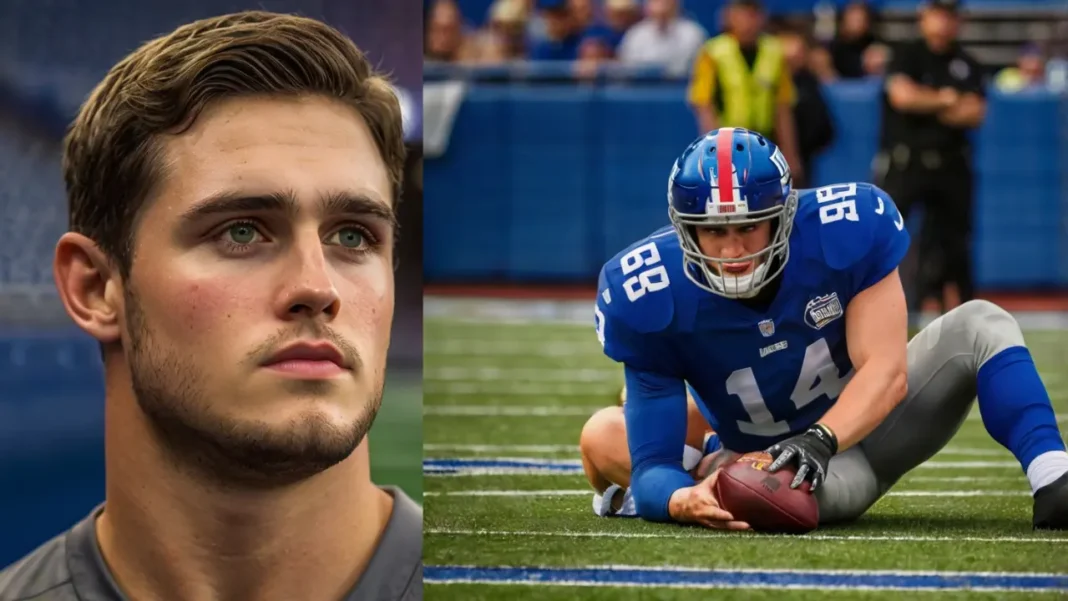The world of professional football is filled with moments of triumph and heartbreak, and injuries are an inevitable part of the game. One such moment of concern is when Daniel Jones, the New York Giants’ star quarterback, suffered a significant injury. This article will delve into the details of Daniel Jones’ injury, exploring its causes, implications, and the road to recovery. We’ll also discuss the impact of his absence on the team and what this means for the Giants’ season.
Overview of Daniel Jones’ Career
Daniel Jones, affectionately known as “Danny Dimes” by fans, quickly rose to prominence as a promising quarterback. Drafted by the New York Giants in the first round of the 2019 NFL Draft, Jones showed flashes of brilliance early on, combining his strong arm with mobility to create plays both in and out of the pocket.
Jones as the Giants’ Starting Quarterback
By his second season, Jones solidified his role as the Giants’ starting quarterback. His leadership on the field, paired with his ability to make quick decisions, made him a critical asset to the team. Despite facing ups and downs, Jones consistently demonstrated resilience, earning the respect of teammates and opponents alike.
The Incident: How the Injury Happened
On a fateful Sunday afternoon, during a crucial mid-season game, the Giants were battling a formidable opponent. The stakes were high, with playoff implications on the line. The game was tense, with both teams trading blows on the scoreboard.
Play-by-Play of the Injury
The injury occurred during the third quarter. Jones, attempting to scramble out of the pocket to avoid a sack, was tackled awkwardly by a defensive lineman. As he went down, his leg twisted unnaturally beneath the weight of the defender. Immediately, Jones clutched his knee, grimacing in pain, signaling to the sideline that something was seriously wrong.
Details of the Injury
Initial Diagnosis
Following Daniel Jones Injury was taken to the locker room for an initial assessment. The medical team feared the worst as they conducted preliminary tests. The initial diagnosis pointed towards a potential ligament injury, a common yet serious ailment for athletes, particularly quarterbacks who rely heavily on mobility.
Medical Examinations and Results
Further examinations, including an MRI, confirmed the suspicions. Jones had suffered a torn ACL (anterior cruciate ligament) in his right knee. This type of injury is severe and typically requires surgery, followed by an extensive rehabilitation period.
Short-Term Impact on the Giants
The loss of Daniel Jones sent shockwaves through the Giants’ organization. The coaching staff had to make immediate adjustments, turning to their backup quarterback to step into the role. The offensive game plan, which was tailored to Jones’ strengths, had to be revamped to accommodate the new QB’s skill set.
Backup Quarterback’s Role
The backup quarterback, thrust into the spotlight, faced immense pressure. While he had experience in the league, replacing a starter like Jones is never easy. The team’s success now hinged on his ability to adapt quickly and manage the offense efficiently.
Long-Term Implications
Jones’ Recovery Timeline
An ACL tear typically requires a recovery period of 9 to 12 months, depending on the severity of the injury and the individual’s response to surgery and rehab. For Jones, this meant a long road ahead, with his season effectively over.
Potential Risks and Challenges Ahead
The recovery process for an ACL injury is arduous. There are risks of complications, such as re-injury or lingering instability in the knee. Additionally, there’s the psychological aspect, as athletes often struggle with confidence upon returning to play after a major injury.
Team Dynamics Without Jones
Changes in Offensive Strategy
Without Jones, the Giants had to shift their offensive strategy. The team leaned more heavily on their running game and short passes to minimize risks. This conservative approach was necessary but limited their offensive potential.
Impact on Team Morale
Jones was not just a player but a leader. His absence was felt deeply within the locker room, affecting team morale. The players rallied together, but the void left by their captain was undeniable.
Fan Reactions and Public Opinion
Social Media Buzz
Fans took to social media to express their concerns and well-wishes for Jones. The injury sparked a wave of support, with #GetWellSoonDanny trending on Twitter. The Giants’ faithful were hopeful for a strong recovery, but also anxious about the team’s chances without their star QB.
Media Coverage
The media quickly picked up on the story, with analysts discussing the implications of Jones’ injury on the Giants’ season. Speculation about potential trades or acquisitions of a temporary replacement quarterback began to circulate.
Comparative Analysis: Similar Injuries in the NFL
Case Studies of Other Quarterback Injuries
Jones’ injury is not unique in the NFL. Other quarterbacks, like Carson Wentz and Joe Burrow, have suffered similar injuries in recent years. Examining their recovery timelines and career trajectories can offer insights into what Jones might expect.
Recovery Outcomes
While some quarterbacks have successfully returned to their pre-injury form, others have struggled to regain their previous level of play. The key factors often include the quality of rehabilitation and the player’s mental resilience.
What This Means for the Giants’ Season
Playoff Hopes
The Giants’ playoff hopes took a significant hit with Jones’ injury. The team, already battling for a spot, now faced an uphill battle. Every game became critical, and the margin for error was razor-thin.
Season Predictions
Analysts began to adjust their season predictions for the Giants. Many expected the team to struggle in the absence of Jones, with a potential drop in the standings. However, the unpredictability of the NFL meant that anything was still possible.
Jones’ Return: Expectations and Realities
Based on typical ACL recovery timelines, Jones could potentially return by the start of the next season. However, rushing back too soon could increase the risk of re-injury, so the Giants’ medical staff will likely be cautious.
Reintegration into the Team
When Jones does return, the team will need to reintegrate him gradually. The coaching staff will closely monitor his progress, ensuring that he is fully ready before taking on the full responsibilities of a starting quarterback again.
Expert Opinions on Jones’ Recovery
Sports analysts have mixed opinions on Jones’ recovery. Some are optimistic, citing his work ethic and determination as key factors that will aid in his comeback. Others are more cautious, highlighting the challenges that come with returning from a significant knee injury.
Medical Experts Weigh In
Medical experts agree that while Jones has a good chance of making a full recovery, the process will be lengthy and demanding. The importance of adhering to a strict rehabilitation protocol cannot be overstated.
Looking Forward: The Future of Daniel Jones
Long-Term Career Prospects
Jones’ future in the NFL will depend largely on how well he recovers from this injury. If he can return to his pre-injury form, there’s no reason he can’t continue to be the franchise quarterback for the Giants for years to come.
What Jones Needs to Focus On
In the short term, Jones needs to focus on his recovery and rehabilitation. In the long term, building confidence and ensuring his knee is strong enough to handle the physical demands of the NFL will be crucial.
Conclusion
Daniel Jones’ injury is a significant blow to both his career and the New York Giants’ season. While the road to recovery is long and filled with challenges, there is hope that Jones can return stronger and more determined than ever. The Giants will need to navigate the rest of the season without their star quarterback, but with resilience and adaptation, they may still find success.
FAQs
1. How long will Daniel Jones be out due to his injury?
Daniel Jones is expected to be out for 9 to 12 months, depending on his recovery process.
2. What is the nature of Daniel Jones’ injury?
Daniel Jones suffered a torn ACL in his right knee, which is a severe injury requiring surgery and extensive rehabilitation.
3. Who will replace Daniel Jones as the Giants’ quarterback?
The Giants’ backup quarterback will step in to replace Jones, though the team may also explore other options.
4. Has Daniel Jones had any previous major injuries?
While Jones has faced injuries in the past, this ACL tear is one of the most significant he has encountered in his career.
5. What impact will Jones’ injury have on the Giants’ playoff chances?
Jones’ injury significantly hampers the Giants’ playoff hopes, making it much harder for the team to secure a spot without their starting quarterback.




